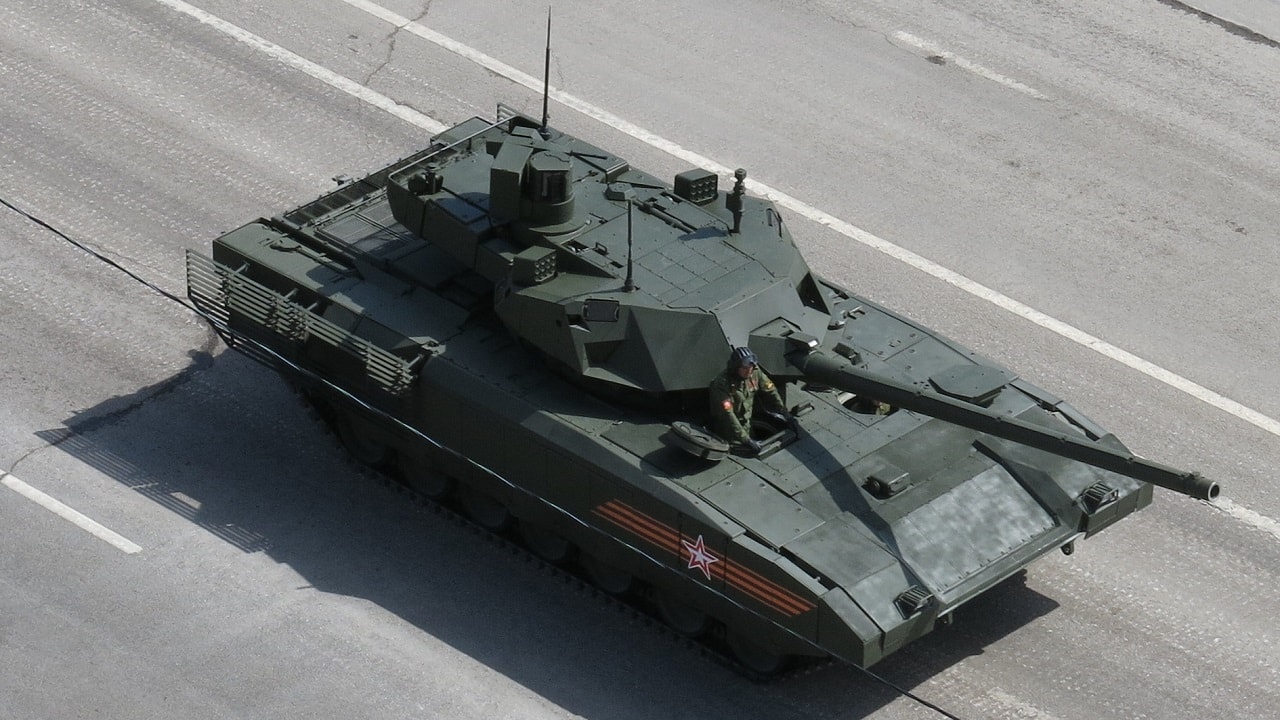The RIA state news agency reported that Russian T-14 Armata main battle tanks have been deployed in Ukraine.
According to RIA, the armored vehicles have been used in combat coordination at training grounds in Ukraine, but they have yet to participate in direct assault operations. The latest-generation Russian tank has reportedly fired rounds targeting Ukrainian assets from a distance.
The Kremlin likely sent in its Armata tanks in an attempt to counter the looming delivery of Western-made MBTs to Ukrainian forces. Moscow understands that in order to compete with the advanced and modern armored vehicles about to fall into the hands of Ukraine’s armored corps, it needs to replenish its dwindling MBT arsenal.
However, the T-14 Armata appears to be another Russian product overhyped by the Kremlin.
A Brief Overview of the T-14 Armata
Initially derived from the Object 197 program, the T-14 was meant to replace the T-90. The MBT first appeared publicly in 2015, when several of these new armored vehicles were detected in Alabino. The Russian Defense Ministry officially announced the new tank months later, during Moscow’s Victory Day Parade.
By 2020, state-run trials of the tank began. While the tank’s introduction to service appeared imminent at this time, Russia’s invasion of Ukraine in February 2022 halted the T-14 program. To this day, only a small number of Armatas have actually been produced, due to high manufacturing costs and supply shortages.
Originally, Moscow planned to produce more than 2,000 t-15 MBTS, but a full allotment will not come into being until 2025 at the earliest.
Specs and Capabilities
The Armata features digitized equipment, an isolated armored capsule and an unmanned turret. Notably, the tank’s exterior mirrors Western designs, specifically its hull and its long, boxy turret. Another new attribute is that the Armata has seven road wheels instead of six. Armament-wise, the MBT is fitted with a 125mm-1M smoothbore gun and a turret that can sport 45 rounds of ammunition.
Additionally, the 2A82 125mm gun can be upgraded while the MBT can support secondary weapons including the PKTM 7.62mm machine gun and the Kord 12.7mm machine gun.
How Will the Tank Fare in Ukraine?
Industry experts and analysts estimate that Russia has lost roughly half of its fleet of tanks in Ukraine over the last 14 months. Moscow’s T-72 and T-80 tanks have been depleted by two-thirds. While some of these MBTs were left behind by Russian soldiers or captured by Ukrainian forces, many did not fare well against the Western-made anti-tank missiles provided to Ukraine over the last year.
The Kremlin has often boasted that its latest-generation T-14 Armata could blow near-peer vehicles out of the water. Considering Russia’s track record of exaggerating weapons capabilities, however, the Armata could very well suffer the same fate as its antiquated predecessors in Ukraine.
The battle for Bakhmut is expected to be the center of warfare in the upcoming spring months. Weighing in at around 10,600 pounds, the T-14 is extremely heavy and difficult to transport. These tanks could sink into the mud as the ground continues to thaw. Also, since the T-14 is so new to combat, maintenance crews are not well positioned to mend these MBTs when damaged.
The Kremlin is clearly sweating as it awaits the incoming wrath of Western MBTs. No matter what Moscow says its new T-14 Armata is capable of, the tank has never been tested in battle and is therefore not reliable.
MORE: The F-35 Now Comes in Beast Mode
MORE: Why the U.S. Navy Tried to Sink Their Own Aircraft Carrier
Maya Carlin, a Senior Editor for 19FortyFive, is an analyst with the Center for Security Policy and a former Anna Sobol Levy Fellow at IDC Herzliya in Israel. She has by-lines in many publications, including The National Interest, Jerusalem Post, and Times of Israel. You can follow her on Twitter: @MayaCarlin.

